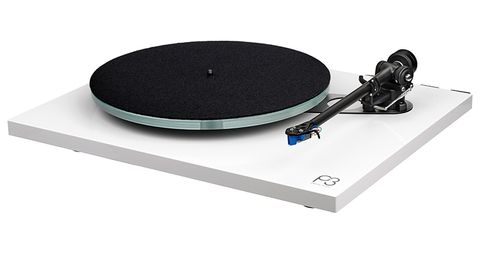The Planar 3 was a progression of Rega Research’s initial vinyl incursion, the Planet, and was released in 1978. This was a bizarre-looking design with three massive cast aluminium alloy spokes to support the record. Because this didn’t work out so well, a common mod was to place a glass mat on top of the Planet’s plate, which is exactly what Rega did with the new Planar. Instead, a thick slice of glass was substituted for the metalwork, which was topped with a felt pad…
The Planar 3’s greatest strength was its arm, a Lustre-made Japanese S-shaped device that was more than adequate for the deck’s already competent motor unit. Rega was able to create an incredibly cost-effective device by combining the Philips Impex AC synchronous motor, which can be found on the Linn and a thousand other belt drive decks. The Planar 3 created particularly pleasant music when used with a good cartridge, such as Rega’s own Supex-derived R100 or A&R’s P77. What it accomplished excellently was provide a very capable all-around performance at a very low price. Wow and flutter were low, rumble was barely heard, and acoustic feedback was minimal if the deck was properly set. This resulted in a pleasant, smooth, open sound that simply seemed to play music without the commotion that suspended subchassis decks like Thorens’ TD160 produced. A Rega never went out of tune once it was installed.
By 1979, the Planar 3 was in such high demand that dealers had to create waiting lists. People were using them with incredibly capable and expensive ancillaries, which were typically three or four times the cost of the deck. Despite Rega CEO Roy Gandy’s refusal to advertise in any hi-fi journals or even provide review samples, sales surged.
Rega performed the inconceivable and modified it by the summer of 1983. The RB300 had arrived when Planars began to appear with strange-looking, long straight black tonearms. This small jewel was far more significant than the Planar 3 itself, and it astounded everyone who came upon it. At the time, £90 got you what was possibly the greatest tonearm in the world. Linn’s Ittok LVII superarm, which cost £253 and was less neutral, less transparent in the mid-band, and lacked the Rega’s soundstaging and information retrieval characteristics, was less neutral, less transparent in the mid-band, and lacked the Rega’s soundstaging and information retrieval characteristics. Rega had performed admirably.
The new Planar 3 came with an RB300 for the modest price of £188, and what a fantastic deck it was! It easily outperformed competitor all-in-one designs, if only for the tonearm. It gave the sound a lot more clarity and sophistication, as well as the ability to employ far superior moving coil cartridges. In fact, the RB300 was far too good for the poor old P3, highlighting all of its flaws. It became less melodious (and more analytical) sounding, as well as little duller — the original silver S-shaped arm having provided a bit of life-enhancing color – than the Lustre-armed deck.
Still, with a cartridge like Audio Technica’s AT-OC9 (a musically, if not financially, synergistic fit), it came close to the super decks. Although it was more likely to be used with Linn’s new K9, with which it played admirably, one of the nicest sounds I ever heard from a Planar 3 was from my own Rega R100 cartridged version, mounted on a Target shelf nailed into the wall. Rega followed up with an upgraded line of cartridges, some of which included Linn Troika-style three-point mountings, but they never sounded quite as good to my ears.
The RP3 succeeded the Planar 3 in 2007, and it’s only marginally better, with a few minor tweaks and a new corporate look. The option of Rega’s high-performance TT PSU motor power supply upgrade kit, which makes the RP3 sound a lot more speed-stable and is unfortunately not available for the Planar, is the most useful. However, the business also offers a bespoke motor upgrade kit for the original Planar 2 and 3 that comprises a new motor and a new mounting method, resulting in a significant increase in speed stability and, as a result, sound.
A used Planar 3 can be had for roughly £100, and £200 will get you a mint example in an unusual color – the 1985 mauve/pink is a particularly unique beast. Make sure the tonearm and main bearings are in good shape, and that the motor is running quietly. If there are any other issues, such as speed instability, a new belt is likely to solve them. Spares, like the deck itself, are inexpensive and plentiful. This is the one to get if you’re new to vinyl or bored of your CDs.






